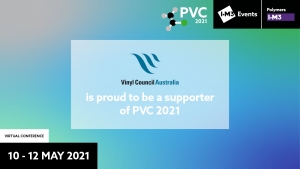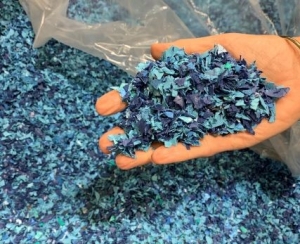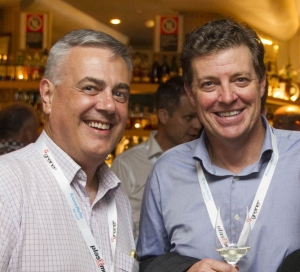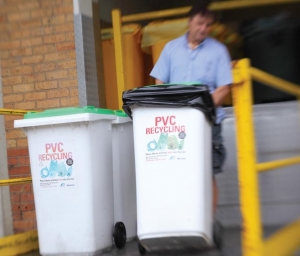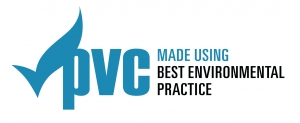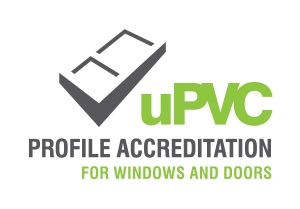Sophi MacMillan
PVC AUS 2026 Speakers
PVC AUS 2026 Speakers
PVC AUS 2026 will feature a range of local and international expert speakers on various key themes and topics across the industry.
Want to be present and be involved in our Queensland 2026 confernce please contact: This email address is being protected from spambots. You need JavaScript enabled to view it.
Watch this space
Global technical conference PVC 2021 goes virtual
The UK-based Institute of Materials, Minerals and Mining (IOM3) has announced it will be moving its triennial global conference, PVC 2021 to an online format.
Focusing on 'Success and Innovation in the Circular Economy', it will run as a fully interactive, virtual conference experience between 10 and 12 May 2021, with emphasis on delivering the exceptional engagement, networking and knowledge exchange between participants, for which the PVC conference series is renowned.
The Vinyl Council of Australia is again proud to partner with this leading event for the vinyl industry.
Usually staged in the UK, as a virtual conference this year, it offers a chance for more participants in the Australasian PVC industry to attend, with the possibility of creating a personalised schedule, networking with attendees (instant chat feature), visiting exhibitors and joining sessions at a click of a button. Registration offers on-demand access after the event and a book of detailed technical conference papers.
Dr Jason Leadbitter, Chair of the PVC organising committee and Sustainability and Corporate Social Responsibility Manager at Inovyn, says, ‘I’m delighted to see the relaunch and opportunity for a fully virtual event that provides a unique opportunity to have the highest-ever participation to either watch live or via immediate streaming. PVC 2021 presents a great opportunity – there is really no excuse to miss out on any presentation.’
PVC 2021 is the world’s leading conference on Vinyl and this year’s theme will focus on ‘Success and Innovation in the Circular Economy,’ with an impressive line-up delivering a current, comprehensive and wide-ranging technical programme with 60 papers covering seven technical sessions, with speakers and discussion opportunities in between.
IOM3 CEO Dr Colin Church CEnv FIMMM, says, ‘The PVC conference series is rightly praised for the extremely high standard of its technical content, and going virtual means this will be accessible for a wider audience than ever. Coupled with the exciting networking opportunities the virtual conference platform offers, PVC 2021 will be an unmissable event for all in the sector.’
Registration to attend PVC 2021 is now live. To find out more about this year’s event and to register, visit www.iom3.org/events-awards/pvc-2021.html
Australian and US vinyl industry bodies explore sustainability program reciprocity
The Vinyl Council of Australia (VCA) and the United States Vinyl Sustainability Council (VSC) have signed a memorandum of understanding (MOU) to explore a pathway to reciprocity between the two sustainability programs by sharing best practices and collaborating on sustainability program development.
Collaboration between the VCA’s PVC Stewardship Program and VSC’s +Vantage Vinyl™ program seeks to promote global harmonization, broaden recognition of industry leaders, and increase industry participation in these sustainability programs.
“While circumstances vary regionally, sustainability is a global issue and vinyl products participate in a global market,” said Sophi MacMillan, VCA Chief Executive. “It is in the best interest of the industry and society to work across borders to help the vinyl industry to continue to make progress.”
Trade association-led sustainability programs serve an important function to advance voluntary improvements in the industry. Working together, member companies can share best practices leading to continuous improvement throughout the industry.
“Many of our members do business throughout the world,” said Jay Thomas, VSC Executive Director. “Developing a pathway to reciprocity between the various sustainability programs will foster progress by easing the administration burden on companies and encouraging more participation. Increased program participation is a key factor in advancing the sustainability of the industry.”
Companies participating in the PVC Stewardship Program and +Vantage Vinyl programs agree to transparent voluntary commitments and guiding principles of sustainability that are measured and reported on an annual basis. The programs are designed to be inclusive for companies at any stage of the sustainability journey but encourage continuous improvement. The overall performance of member companies is reflected in annual sustainability reporting.
To learn more about the PVC Stewardship Program visit https://www.vinyl.org.au/sustainability/stewardship and https://vantagevinyl.com for more information about +Vantage Vinyl.
###
About the Vinyl Sustainability Council
The Vinyl Sustainability Council (VSC), founded in 2016 in partnership with the Vinyl Institute, is a council created to advance the vinyl industry’s efforts in addressing sustainability in the United States. The VSC is a collaborative platform for companies, organizations and other industry stakeholders to come together to create a sustainable development path for the industry. For more information, please visit vantagevinyl.com/vinyl-sustainability-council/.
Vinyl Council secures government funding for new ‘TexBack’ PVC composite recycling scheme
The Vinyl Council of Australia (VCA) and its project partner, Specialised Textiles Association (STA) have secured Government grant funding of nearly $350,000 to further research into the recycling of waste PVC and polyester composite textile products in Australia.
Their TexBack project is one of only 15 successful grant applications (out of a total 190 submissions) and will receive $349,850 from the National Product Stewardship Investment Fund (NPSIF). The Government’s funding program was launched to promote and stimulate shared action for everyday products with a focus on working to reduce waste generation and increased resource recovery.
‘TexBack’ is an industry-driven initiative which aims to steward polyvinyl chloride (PVC)-polyester (PES) composite textile products and waste which are currently not recovered in Australia.
The Morrison Government’s grant will fund the development of the business case for a national product stewardship scheme for textiles such as grain covers, tarpaulins, advertising banners, tents and marquees, roofing and grounds sheets, truck tarps, marine fabrics, swimming pool liners and upholstery fabrics. The project covers a range of activities, including testing of a new chemical separation technology, that will enable the specialised textiles and vinyl sectors to address the growing concerns of waste ending up in landfill.
The NPSIF has projected 1.5 million tonnes of waste to be diverted from landfill through the initiative and will further boost the economy by creating more than 560 potential jobs.
Developing a uniquely Australian solution will pave the way for the establishment of a new, industry-led product stewardship scheme that recovers a complex local waste stream, reprocesses it within Australia and supports the local manufacture of an innovative recycled content PVC building product being developed here, with export market potential. Local markets for recovered polyester will also be sought.
Welcoming the grant, the Vinyl Council of Australia’s PVC Stewardship Manager, Jan van de Graaff said: “TexBack will build on earlier VCA-led research into potential recycling options of PVC coated fabrics conducted over the past four years.
“This grant now gives VCA and STA a real opportunity to collaborate to engage the textile sector in developing a viable scheme for recovery and reprocessing of this waste stream, particularly as there is a potential end-use for the material that will lead to manufacturing of a completely new durable building product in Australia.”
Ana Drougas, Executive Office for the STA said “We are excited to be working with the VCA in an Australian first project to pilot the introduction of innovative and uniquely Australian world-leading PVC Separation technology. We acknowledge and commend the Commonwealth Government for elevating the status of product stewardship as a means of addressing environmental sustainability, growing jobs and the economy.”
In announcing the grant recipients, Minister for the Environment, Sussan Ley said: “We have made it clear that industry needs to take action for their waste. We are investing $10.5 million to seed 11 new and expand four existing industry-led initiatives that will make a practical environmental difference and it is great to see industry respond strongly to our call.”
“Our seed funding, along with the reforms in our Recycling Act, empowers industry and product experts to take more responsibility for their products,” said Hon Trevor Evans MP Assistant Minister for Waste Reduction and Environmental Assistant Minister.
“The grants were six-times oversubscribed which clearly shows the appetite in Australia for putting the power of recycling into the hands of businesses and consumers.”
For more information on the funded product stewardship schemes, visit: https://www.environment.gov.au/protection/waste-resource-recovery/product-stewardship/national-product-stewardship-investment-fund
The value of product stewardship
In the current business climate, the application of product stewardship has much to offer to individual businesses, industry collectives and governments seeking to drive sustainable economic growth.
This has been brought into a sharper focus in recent times due to the global economic downturn triggered by the covid-19 pandemic which has led many businesses and governments to recognize the level of economic dependence they have on offshore suppliers and markets, including for waste materials. This, coupled with the impact of the China National Sword policy, has the potential to stimulate new ways of thinking and smarter approaches to business and economic management and prosperity. One such approach, and one that has considerable merit, is product stewardship.
Product stewardship is defined as “the principle that everyone involved in a product supply chain - including raw material and component suppliers, product and packaging manufacturers, brand owners, recyclers, governments and consumers - share responsibility for minimising environmental impacts over that product’s life cycle” . Product stewardship can therefore make a significant contribution to the circular economy. Stewardship, at its best, takes a life cycle thinking approach to ensure products and materials are designed to avoid adverse impacts on society and the environment and that the resources consumed are retained within the productive economy in a cyclical manner.
The Vinyl Council, through its PVC Stewardship Program, has been at the forefront of this journey in Australia for quite some time. The Program commits Signatories to implement life cycle thinking and consider the whole-of-life impacts of the products that they introduce to the marketplace. This encompasses a wide range of considerations including raw materials and resources, embodied carbon, toxicity, and lifespan. This has resulted in the sector producing products that deliver proven environmental benefits, as a function of their excellent performance, durability, low waste generation and affordability which has been borne out through numerous lifecycle assessments carried out globally and locally.
Furthermore, when stakeholders collaborate, opportunities arise for better resource management, which in turn can stimulate local employment and deliver greater security and access to the inputs needed by local manufacturers. The Vinyl Council is pleased Federal and State Governments have recently announced funding programs which may provide opportunities to bring together innovators and entrepreneurs to develop new systems and infrastructure, or products, which will lead to enhanced recovery and reprocessing of greater volumes of PVC for the domestic market.
The Council firmly believes that a product stewardship focus can translate into tangible financial and reputational benefits for those organisations that embrace and commit to implementing product stewardship approaches. These benefits are evident both in the public realm but also in the disciplines it enforces on organisations in terms of how they manage and monitor their day to day operations.
Furthermore, acting as leaders through product stewardship delivers:
- Differentiation in the marketplace that leads to competitive advantage. Establishing stewardship credentials through independent third-party schemes, as the PVC program does, demonstrates not only a company’s commitment to continuous improvement but may also differentiate it from competitors. Increasingly, down-stream customers want to know how their suppliers manage their environmental affairs. Independent and third-party verified schemes enable those involved to spruik their credentials and demonstrate their accountability and
transparency. - Access to markets. At present, governments at all levels are reviewing their procurement frameworks and policies to examine how these systems can be used to support and stimulate circular economy objectives, including boosting demand for recycled content products. In doing so, governments are likely to preference those businesses who are members of recognised and reputable product stewardship schemes. This will facilitate access to markets for those businesses participating in these stewardship schemes.
- Reducing liability. A company is best positioned when it understands its products holistically. Product stewardship, particularly a life cycle-based scheme, fosters a proactive approach within businesses to consider the supply chain risks and the various lifecycle stages of the products they are releasing into the market. It therefore reduces risk and better prepares them for future challenges.
- More effective business management. Implementing product stewardships schemes within businesses imposes disciplines around establishing appropriate systems that enable organisations to measure performance, monitor outcomes and control direction. This can aid in minimising risks, enhancing profitability as well as in fulfilling obligations in relation to regulatory compliance.
- Strengthening organisational culture. Embedding environmental and social sustainability as core values of a business’ operations can support buy-in and pride from its workforce.
With a significant track record of driving change through the industry since 2002, the PVC Stewardship Program is an example of voluntary stewardship bringing benefit to both industry and community.
If you are an Australian business operating in the vinyls product sector and are interesting in learning more about our PVC Stewardship Program, please don’t hesitate to contact us on 03 9510 1711.
For our latest results, please check out our annual Progress Report.
Vinyl Council appoints new Chairman
Matthew Hoyne (L), Chairman and Rob McLorinan (R), Vice Chairman
The Board of the Vinyl Council of Australia has elected a new Chairman following the decision by Ian Rayner (Managing Director, Breathe Fresh Australia Pty Ltd) to retire as Chairman after eight years at the helm.
Taking over the role is Matthew Hoyne, Director and General Manager of vinyl compounder and recycler, Welvic Australia.
Ian has supported the Council with his extensive management and industry experience since his appointment as Chairman in 2012 and as a Director since 2005. He has steered the Council through the major industry restructure in 2016 when the country’s only resin producer ceased manufacturing, as well as through the current, challenging pandemic. The strength of the Council today as the peak association for the vinyl industry is testament to Ian’s leadership. He will remain on the Board as a Director.
Matthew Hoyne’s role as Chairman commenced on 25 August. Matthew has served on the Council Board as a Director since 2009 and has been the Treasurer and Deputy Chairman for the past eight years.
He brings over 26 years of experience in the plastics industry having held several technical and commercial roles with different plastics manufacturers. He has been a part owner and Director of Welvic Australia since 2006.
Matthew has been a member of the Council’s Technical Steering Group for the PVC Stewardship Program and currently chairs the PVC AUS conference organising committee and the PVC Circularity Task Force.
The Council’s Board currently has eight directors, including Matthew. These are:
- Vice Chairman/Treasurer: Mr. Rob McLorinan - General Manager, Armstrong Flooring Pty Ltd
- Mr Brad Scharenguivel – Country Manager, Deceuninck Australia
- Ms Cindy Bray – Executive General Manager, Plastic Industry Pipe Association of Australia Ltd (PIPA)
- Mr David Cooper - General Manager, Australian Vinyls Corporation Pty Ltd
- Mr Dieter Klamann – Managing Director, Chemson Pacific Pty Ltd
- Mr Ian Lilja – Group Technical Advisor, Sun Ace Australia Pty Ltd
- Mr Ian Rayner - Managing Director, Breathe Fresh Australia Pty Ltd
Vinyl Council of Australia welcomes Federal Government’s A$1 billion recycling plan
The Vinyl Council of Australia welcomes the Federal Government’s commitment of $190 million into a Recycling Modernisation Fund (RMF) that is expected to ‘drive a billion-dollar transformation’ of Australia’s waste and recycling capacity.
The RMF will support innovative investment in new recycling infrastructure to sort, process and remanufacture materials, including mixed plastics.
“We believe this funding is much needed, well targeted and an excellent opportunity to refine the current systems,” says Sophi MacMillan, Chief Executive of the Vinyl Council of Australia. “Australia lags Europe and numerous other countries around the world in terms of sorting, recovery and recycling of mixed plastics and this fund has the potential to help bridge this gap.”
The Vinyl Council has long been calling for this waste to be sorted more thoroughly, enabling plastics such as vinyl to be recycled.
The third most commonly used type of plastic, vinyl (or PVC as it is also known) is used in virtually every sector of the economy from healthcare devices, consumer goods, food and agriculture to education, building and infrastructure. Due to its excellent durability, vinyl is mostly used in long life applications but also some niche packaging applications for its specific functional properties. Although relatively small volumes present in the waste stream annually, these low volumes have often mitigated against investment in developing collection, sorting, and processing infrastructure.
The Vinyl Council believes new investment is needed in a range of systems and technologies to enable recovery, material separation and recycling across our communities and sectors, as well as improved policy drivers that address and incentivize the system holistically from managing waste as a valuable resource to use of recyclate in well-designed, high value, new products.
Since 2002, the Vinyl Council’s PVC Stewardship Program, which commits participating companies to strive for continuous improvement in the environmental footprint of PVC products, has encouraged improved recycling practices for vinyl products in Australia. Signatories have committed to using recycled PVC in new products, particularly in industrial, building and infrastructure products, as well as minimising production wastes and packaging waste sent to landfill.
Annual reporting has found the amount of PVC being recycled by local manufacturing Program signatories grew for a third successive year in 2019 and is now more than double the amount used in 2016.
Ensuring sufficient, consistent local supply of quality recyclate for these manufacturers going forward is a challenge. The Vinyl Council is optimistic that the funding package announced by the Honourable Sussan Ley, Minister for the Environment, will help address this and enable the vinyl resource stream to be retained within the productive economy.
“As our core purpose is to enhance the industry’s opportunities for sustainable growth, we have been working with members and stakeholders to improve PVC recycling,” MacMillan explains. “Our PVC Circularity Taskforce brings together industry and government representatives to drive the industry’s circular economy objectives.
“Working with this forum and with the support of the Federal Government and interested State jurisdictions, we believe we can fast track new technologies that produce suitable clean and sorted PVC for remanufacture locally”, she adds.
Further investment in source separation of wastes and secondary sorting facilities would support the recovery of, for example, rigid PVC packaging materials, which are readily recyclable but often not separated from the co-mingled plastics waste stream.
“We look forward to mobilising and realising these opportunities with interested State Government agencies to improve environmental outcomes and stimulate employment, particularly given the current economic challenges,” MacMillan adds.
“Our members are committed to the circular economy, which has the opportunity to grow substantially if all levels of government harness their purchasing power to support those companies that are active participants in product stewardship schemes and are manufacturing recycled content products.”
Technical report highlights good fire performance of PVC
PVC used in windows and building products has proven performance benefits in the event of fire due to its inherent flame retardancy, that will not cause, support or enhance the development of fire. Sophi MacMillan, Chief Executive of the Vinyl Council of Australia analyses the latest technical guidance on PVC fire safety.
PVC, or vinyl, is the most widely used polymer in building and construction applications with up to 70% of global annual PVC production used in this sector. Plastic products contribute to greater building energy efficiency, cost savings, construction safety, lower embodied carbon and design versatility.
The material’s increasing use over the last six decades in construction and furnishing of buildings has led to a thorough assessment of its fire performance that shows the distinct advantages of uPVC (unplasticised or rigid PVC) over many other building materials, including timber, in the event of fire. Crucially, PVC, especially unplasticised PVC (uPVC or PVC-U) has inherently superior fire performance due to its chlorine content that acts as a natural fire retardant, setting it apart from other polymers such as polyethylene.
Specifiers, architects, construction and fire professionals can learn more about the material’s credentials in the 2019 ISO Technical Report: ‘Plastics – Guidance on fire characteristics and fire performance of PVC materials used in building applications’, which serves as a valuable technical reference document for the specification of PVC products at the design or pre-building phase.
So, what are the benefits of PVC fire performance characteristics and how can these contribute to enhanced safety in the event of fire?
uPVC is inherently fire retardant: The high chlorine content of uPVC acts as a natural flame retardant, greatly reducing its combustibility. Unlike most timber building elements, uPVC building elements (such as window frames and permanent formwork) do not support combustion and are in fact self-extinguishing. In reaction to fire tests, the report states that due to its high content of chlorine, ‘PVC-U displays a high resistance to ignition, a low rate of heat release, and self-extinguishes when the external heat source is removed’.
uPVC is slow to ignite: uPVC is far less likely to burn due to its resistance to ignition, thus contributing to fire safety. The temperature required to ignite uPVC (391 degrees C), such as that used in window profiles and permanent formwork, is higher than that needed for wood (260 degrees C).The report’s comparison data of some results for PVC with those of other materials regarding ignition times and heat flux values to cause ignition respectively ‘illustrate the good ignition resistance’ of PVC materials.
uPVC is self-extinguishing: Most PVC formulations are not just difficult to ignite - they will self-extinguish when the flame source is removed because of the high levels of chlorine present in PVC. This makes PVC particularly suitable for rigid applications such as windows, doors and permanent formwork & lining used in construction, and is a significant positive for fire safety.
uPVC has a limited flame spread compared to other materials: Burning uPVC chars and will self-extinguish if the external heat or flame source is removed, making it inherently resistant to flame spread. It rarely produces flaming droplets or burning debris, which are a major cause of flame spread. Generally, uPVC profile has a low flame spread index (FSI) value of 15 to 20. In comparison, Douglas fir/cedar plywood FSI value is much higher at 190-230.
uPVC permanent formwork systems have been tested to AS5113 (BS8414) façade test and successfully passed the no flame spread criteria, and tested to AS1530.3 to achieve Spread of Flame Index of 0.
uPVC heat release: Heat release is a key factor regarding fire safety. Data on measurement of peak heat release rates (PHRR) and fire performance index (FPI) values shows that PVC materials ‘behave well’ when compared to other polymers and timber.
For example, uPVC permanent formwork systems have been tested to AS1530.3 to achieve Heat Evolved Index of 0.
In room-corner fire tests on wall-lining materials, the PVC systems outperformed the others, including wood, polycarbonate and FR ABS, with substantially lower average and total heat release rates. None of the PVC materials caused flashover. The study also showed that the low flame spread/low heat release characteristics of PVC materials tend to also exhibit low smoke release.
uPVC smoke density and toxicity in fires: Burning PVC releases a heavy smoke. However, smoke measurement tests show that PVC materials do not present a significantly greater smoke hazard than many other commonly used materials.
PVC and fire safety. In the context of fire safety objectives, survey data shows that only 10% to 15% of all plastics in a private house are in construction products. A much higher proportion (85% to 90%) of plastics are brought into a building by the occupants, such as furniture, household and technology appliances, toys and packaging.
As a strong, recyclable and versatile building material, with inherent fire retardancy, PVC is an excellent safe and long-life choice for myriad construction applications.In Australia, uPVC window frames have been developed and tested specifically to meet construction requirements for designated Bushfire Attack Levels (BAL) within Australian Standards for Construction in Bushfire Prone Areas (AS 3959:2009). And uPVC permanent formwork systems can meet BAL FZ (flame zone) construction requirements.
uPVC windows with metal reinforcing are permitted in zones classified as up to BAL-29 (where the number represents the heat flux in kW m²) risk. Some u-PVC window systems have been independently tested and comply with AS 1530.8.1 which permits their use in zones BAL-40 and above.
While people are, naturally and rightly, concerned about combustibility of plastics, it is important to understand the difference between the characteristics and properties of different polymers. And crucially, that PVC’s high chlorine content (57%) - a fire retardant -sets it apart from other polymers.
Australian manufactured uPVC permanent formwork systems have extensively been fire tested to demonstrate their fire performance compliance with the relevant requirements of the NCC. These fire tests include (but are not limited to) AS5113 (BS8414) façade fire test, AS5637.1 (ISO9705) room test classification test, AS1530.4 fire resistance level testing, and AS1530.3 fire hazard indices test.
PVC is undoubtedly one of our most successful modern synthetic building materials that has undergone rigorous assessment on its effect on health and the environment. It is time to reassess our attitudes towards this proven safe material.
Best Practice PVC - Have your say
Launched as a product verification scheme in 2010, Best Practice PVC sets stringent criteria for manufacturing PVC products and addressing their end of first use. Best Practice PVC products, independently verified as fully compliant wit the scheme, are recognised in Green Star building rating tools, as well as other public and private procurement policies in Australia.
In this first major review of the scheme and its criteria, proposed by the Green Building Council of Australia to be conducted by the Vinyl Council, we are seeking feedback on aspects of PVC manufacturing and supply chain performance globally that may lead to updating or including new criteria to represent current 'best practice'.
We have released a Consultation Paper on potential scheme criteria and invite your input on the future direction of the scheme. Options outlined in this paper were drafted based on the proposed, revised approach of the Green Star building rating tools to building products (refer to Green Star Future Focus), the existing PVC Stewardship Program, and current trends in PVC manufacture.
In this paper we pose questions on:
• Potential gaps in current Best Practice PVC criteria;
• Alignment with the PVC Stewardship Program and other schemes’ criteria;
• Possible approaches to be introduced;
• Other issues that a future scheme might include.
We want to hear from you!
We ask that you consider the current and proposed scheme criteria and strategic options discussed and provide input by 7th July 2020. You can provide feedback by:
- Using this form (MS Word) and emailing it to This email address is being protected from spambots. You need JavaScript enabled to view it.
- Through SurveyMonkey: https://www.surveymonkey.com/r/BEPupdate. The survey will take only 10 minutes to complete.
Your feedback will be kept confidential, and any published results will be aggregated and anonymised. Your contact information will be taken and retained solely for the purpose of reviewing and improving the Best Practice PVC scheme.
Find more information on Best Practice PVC and PVC product recognition in Green Star here.
Download the Consultation Paper and feedback form.
Plustec is the first uPVC window profile supplier to achieve national industry accreditation
Vinyl Council member, Plustec Pty Ltd, based in NSW, has become the first uPVC profile supplier to achieve accreditation under the country’s Industry Code of Practice (ICP) for vinyl profiles used in windows and doors in Australia. The company is also one of only two companies that extrude uPVC window profiles locally.
Developed by the Vinyl Council of Australia, the uPVC Window Alliance’s initiative is designed to provide greater confidence to specifiers, builders and consumers in the durability of uPVC profiles under Australian climatic conditions and to reduce concern that uPVC profiles may discolour under high UV conditions.
The ICP sets specific composition, weathering resistance, colour and strength requirements for extruded uPVC profiles for use in windows and doors in Australian buildings. Assessments of profile performance to the ICP requirements are made by third party accredited testing laboratories and require physical exposure of the profiles to one of the highest UV radiation exposure standards for these products in the world. This means that purchasers of Australian-made u-PVC window and doors holding this new accreditation can be confident that the products have been tested to withstand Australia’s higher UV conditions.
Sophi MacMillan, Chief Executive of the Vinyl Council of Australia comments: “Through our uPVC Window Alliance initiative, all local uPVC profile suppliers supplying products in Australia who achieve this trade mark have demonstrated that their products can reliably meet the highest standards required, both to meet our more extreme climatic conditions and those expected by prospective purchasers.
“Consumers in Australia buying uPVC windows expect, quite rightly, that these can cope with a harsher climate. That’s why we have introduced the new testing requirements and trade mark with stringent compliance requirements to provide customers with greater confidence in the durability of uPVC products in Australian climatic conditions.
“We not only encourage people to choose uPVC windows for quality high performance windows, we encourage them to ask for this mark.”
Tracy Wakefield, Managing Director of Plustec comments: “As a small company, we are extremely proud of this ‘trailblazing’ achievement that has taken considerable time to go through the rigorous testing regimes. It is exciting that the first accreditation is for an Australian-made product.
“We designed our profile specifically for the Australian market and the ICP accreditation endorses our efforts to make a profile specifically suited to Australia’s needs. It makes our effort worthwhile!”
The use of uPVC (unplasticised PVC, or vinyl-framed) double-glazed windows has been growing in Australia as they not only perform well in keeping cold out of a building and heat within; they also work to keep summer heat out and the cool air inside.
Well-established in Europe, the UK and US, where they are the dominant window type used, a key benefit of uPVC high performance windows is their ability to balance optimisation of heating and cooling loads with consumers’ desire for greater natural light.
The excellent thermal insulation of the uPVC frames combined with insulated glass units and airtight sealing mean less energy is needed to maintain an ambient temperature within the home, which is reflected in cost savings, lower energy bills and improved levels of comfort. This makes them an ideal energy-efficient and cost-effective solution for Australian homes where homeowners like large areas of glazing and plenty of natural light.
Given that Australia has the highest solar radiation per square metre of land of any continent, it is important that products used in Australian buildings are formulated and designed for the climate. The ICP for uPVC window and door profiles is much higher than even the ‘Severe’ climate test for warmer parts of southern Europe, the US or China.
Suppliers seeking ICP accreditation must have their profiles independently tested near Townsville, Queensland, Australia’s only natural outdoor weather resistance testing laboratory. The ICP also covers polymer quality and restrictions on legacy additives, while allowing recycled PVC to permitted levels.
Sophi adds: “Congratulations to Plustec on being our first fully accredited supplier of uPVC profiles for the Australia market. We look forward to welcoming other profile suppliers seeking to achieve the mark and, in turn, offering weathering resistance confidence to their customers here.”




